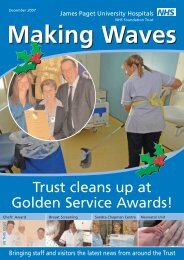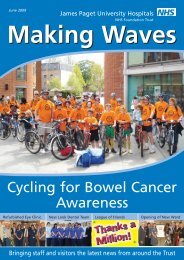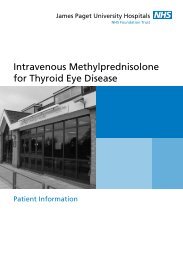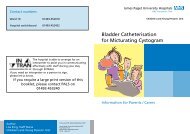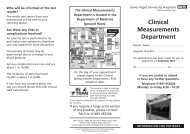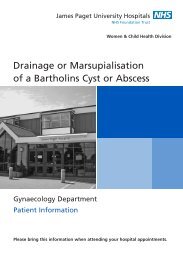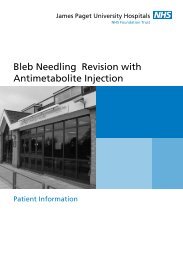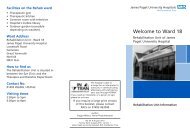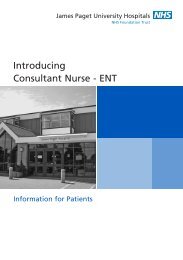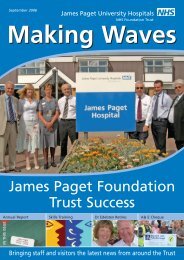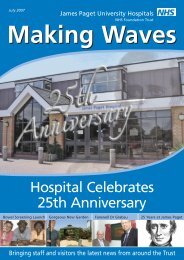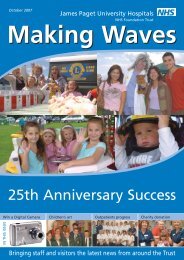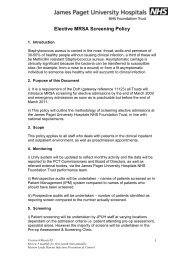Making Waves June 2011 - James Paget University Hospitals
Making Waves June 2011 - James Paget University Hospitals
Making Waves June 2011 - James Paget University Hospitals
You also want an ePaper? Increase the reach of your titles
YUMPU automatically turns print PDFs into web optimized ePapers that Google loves.
News<br />
Project Kenya<br />
In October/November 2010, I fulfilled a life-long dream by joining a community volunteer programme in Kenya. I tried my<br />
hand at everything, from animal and plant conservation, going on safari, bricklaying, whitewashing walls (with the company<br />
of a tarantula!), plastering and roof making, teaching (lots of playing with the children, singing and dancing with the ladies!),<br />
cooking and serving up the local delicacies. I had so much fun whilst also helping to transform and develop the community.<br />
The turning point of the adventure was when I was<br />
introduced to a local family affected by ‘Jiggers’. A Jigger<br />
(or chigoe flea) is a small sand mite that borrows into feet<br />
to harvest their eggs; once infected the egg sack has to be<br />
removed whole by a needle. It can also be spread to other<br />
warm areas of the body such as the hands.<br />
They cause infection, pain and disability, making it<br />
increasingly hard for those infected to perform daily tasks,<br />
such as looking after their crops and animals, as well as<br />
climbing the banana and coconut trees to collect food.<br />
In some communities, it is a stigma and can lead to those<br />
infected being exiled from the village.<br />
During our visit to the<br />
local school we were asked<br />
to help make some posters<br />
for the students to engage<br />
with. It is here that I created<br />
an idea called Neat Feet,<br />
Happy Hands to explain the<br />
importance of sanitation.<br />
Simple hygiene measures -<br />
like sweeping the floor to<br />
their homes and bathing feet<br />
regularly in antiseptic - can<br />
really make a big difference.<br />
The basic premise for the<br />
scheme was a simple poster<br />
represented by a Tree (the<br />
roots signifying the importance of Feet and the branches<br />
our Hands). I also spoke to the local doctor, Benson, camp<br />
manager Duncan and Camp Kenya organiser Dipesh about<br />
the effects and treatment of jiggers.<br />
On my return to the UK I was determined to do<br />
something positive and decided to expand the Neat<br />
Feet, Happy Hands campaign. I kept in contact with the<br />
community and set up a<br />
JustGiving page linked<br />
to Camps International<br />
(Registered charity no.<br />
1125858) to raise funds<br />
and awareness for the<br />
village. With the help of<br />
my son, I re-created my<br />
little wax crayon poster<br />
into something more<br />
visual. Having sent some<br />
posters out to the camp,<br />
I then made t-shirts and<br />
vests to sell as part of the<br />
campaign.<br />
Ben, Duncan and<br />
Dipesh have since<br />
managed to organise local<br />
sponsorship and the local<br />
health authority have also got involved – meaning they will<br />
provide antiseptic and medications to treat the infection.<br />
Neat Feet, Happy Hands has now become one of Camp<br />
International official health projects and will continue to<br />
treat affected children in the village, as well as hopefully<br />
extending it to other communities. Never for one moment<br />
did I imagine my simple drawing done by the light of my<br />
little head torch, would have such an impact!<br />
For anyone thinking of going on volunteer programme,<br />
I say – DO it! It was one of the best things that ever<br />
happened to me – a sense of personal achievement, pride,<br />
satisfaction and absolute fun! There are further fund raising<br />
events planned and a return trip to Kenya – my second<br />
family!<br />
Sister Alison Thayne<br />
Project Facilitator, Dementia Care<br />
Behind the little window –<br />
what goes on in the Pharmacy?<br />
Over the last three years I have been a patient four times at JPUH. I always speak very highly of all<br />
aspects of my stays, but I did notice that many patients were discharged by their Surgeon or Doctor,<br />
only to find that they could not leave or be collected by their relatives for some time because they<br />
had to wait for their drugs from the pharmacy.<br />
On occasions, this could take up to three hours or so. Although I was aware the hospital pharmacy<br />
is very busy with the large numbers of drugs it has to prescribe to both patients, wards, theatres etc, I wondered if the<br />
discharged patients could receive their drugs sooner, thereby allowing their beds to be vacated.<br />
I have visited the pharmacy a few times and seen the little service window which gave me the impression the<br />
department was quite small.<br />
I was given the opportunity to take a tour of the pharmacy and be shown around by the Chief Pharmacist, David<br />
Todd. My first big surprise was to see how big the pharmacy was, with over 40 staff. I was very impressed with the<br />
robotics, the computer controlled machines which control receiving, storing and issuing drugs. David explained the<br />
system of how drugs were issued and checked and explained the stock control and purchasing.<br />
Grateful patient – John Calthorpe<br />
www.jpaget.nhs.uk <strong>Making</strong> <strong>Waves</strong> Newsletter <strong>June</strong> <strong>2011</strong> Page 7



